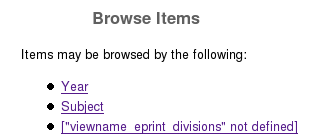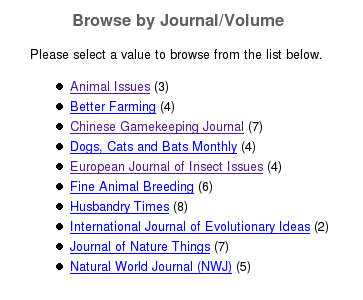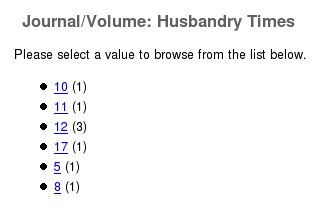Adding new views
| This page is under development as part of the EPrints 3.4 manual. It may still contain content specific to earlier versions. |
Browse views provide a way for visitors to your site to discover relevant content without a specific item in mind (for example, browsing all the content associated with a particular topic). Visitors arriving directly at the page for a specific item in the repository (for example, via a search engine) also use views you have defined to discover related content.
There are two default views in EPrints - By Year and By Subject. This guide describes how to add additional views to your repository.
Contents
The basics
The views for your repository are defined in the views configuration file:
/opt/eprints3/archives/ARCHIVEID/cfg/cfg.d/views.pl
Open this file and find the browse_views configuration setting:
$c->{browse_views} = [
{
id => "year",
fields => "-date;res=year",
...
},
{
id => "subjects",
fields => "subjects",
...
},
];
The views are defined using a special (Perl) syntax: the view definition consists of a pair of curly braces (note the comma after each closing brace) enclosing a list of property/value pairs (note the comma after each line).
The key part of the view definition is the fields property. This names the metadata field (or fields) that EPrints will use to construct the view. For example, for the By Year view, EPrints groups the records in the repository according to their date (note that the res=year suffix tells EPrints to only consider the year part), and constructs a Web page for each date listing the records. Similarly, the Browse by Subjscts view, groups the records according to the subjects they have been assigned to (a record may appear in more than one group!).
Both the Browse by Year and Browse by Subject views are constructed using the values of a single field (date and subjects respectively).
It is also possible to construct a view using the combined values of two or more fields (eg. group records by author and editor), or even using a sequence of two or more fields (eg. group records by journal title and then by volume number).
Worked example: browse by organisational structure
By default, EPrints has a divisions metadata field which allows authors to associate their deposits with the divisions (units, faculties, schools, departments, institutes, centres..) that were involved in producing their item (for example, the author's department, and the departments of any co-authors). This worked example allows visitors to browse the repository content by division.
Open the views configuration file:
/opt/eprints3/archives/ARCHIVEID/cfg/cfg.d/views.pl
Add the following definition to the browse_views setting:
$c->{browse_views} = [
{
id => "year",
...
},
{
id => "subjects",
...
},
{
id => "divisions",
fields => "divisions",
order => "-date/title",
hideempty => 1,
},
];
Save the file and generate the new view pages (this will also re-generate any existing views defined in the views configuration file):
bin/generate_views ARCHIVEID --verbose
Open the view page in a Web browser:
http://your.repository.url/view/
The view page lists all the available views. You should see your new views on the list:
Fixing the undefined phrase warning The new view may appear on the views page with an undefined phrase warning (you may also notice a similar warning message when running generate_views):
["viewname_eprint_divisions" not defined]
Each view you create needs to be assigned a human-readable name, which EPrints will use on the view Web pages.
Edit the language-specific phrases file for view names:
/opt/eprints3/archives/ARCHIVEID/cfg/lang/en/phrases/views.xml
Add an appropriate phrase which describes the new view, for example:
<epp:phrase id="viewname_eprint_divisions">Division</epp:phrase>
Save the phrases file and regenerate the view pages:
bin/generate_views ARCHIVEID --verbose
Example view definitions
Browse by type
Every deposit in EPrints has a type (article, book, thesis...). To allow visitors to browse your repository content by type, add the following definition to the browse_views setting:
{
id => "types",
fields => "type",
order => "-date/title",
hideempty => 1,
},
Browse by author
Example views (combined fields)
Browse by author and editor
Example views (multiple fields)
Browse by journal title, then by volume
This example lets visitors browse the journals items in your repository have been published in, and then volumes within each journal.
{
id=>"journal_volume",
fields=>"publication,volume",
order=>"-date/title",
hideempty => 1,
},
Linking in your view
You now need to add a link to your repository pages which takes visitors directly to your new view, or to the views page from where they can access all available views.
Generating CVs etc
Linking items back to views
Views as collections
New options in EPrints 3.1
subfield no longer supported
The subfield option is no longer supported in EPrints 3.1.
new_column_at
This is an array of integers representing the number of items in a view list before another column is added. For example:
[ 10 ]
This would have one column of values until there were 11, then there would be 2 columns.
[ 10, 10 ]
This would have one column if there were ten or less values, two columns if there were between eleven and twenty (ten + ten) values, and three columns for all other cases.
[ 0, 0 ]
This would always have three columns.
Add one to the number of integers in the array and you get the maximum number of columns. The value of each integer defines the point at which that column becomes full, and more values cause an 'overflow' into the next column.
variations
This controls the various ways in which a browse view can be subheaded. It consists of a list of strings. Each string is the name of a non-compound metadata field (or the keyword DEFAULT, for an unsubheaded list), optionally followed by a semi-colon and a comma separated list of options. E.G:
variations => [ "creators_name;first_letter", "type", "DEFAULT" ],
The following options are available:
reverse
Reverses the order in which the groupings are shown. Default is the ordervalue for that field (usually alphanumeric). Useful for dates as you may want the highest values first.
filename
Changes the filename of the view variation. The default is the name of the metadata field used, so if two variations use the same metadata field with different options, this is needed.
filename=different_filename
first_value
If a field is multiple, only use the first value. Otherwise each item will appear once for each value.
first_initial
If using a name, truncate the given name to the first initial. This will make items like "Les Carr" and "Leslie Carr" appear together. Note it will also make "John Smith" and "Jake Smith" appear together too, showing that you really never can win.
first_letter
The same as 'truncate=1'
truncate
Use the first X characters of a value to group by. truncate=4 may be useful for dates as it will group by the first four digits (the year) only.
truncate=4
tags
Useful for fields like keywords where values may be separated by commas or semi-colons. The value is split on these two characters ( , and ; ) and a heading is created for each.
cloud
Creates a tag cloud. Sets jump to 'plain', cloudmax to 200, cloudmin to 80 and no_separator, then resizes the jump-to links according to frequency of use.
cloudmax
The % size of the largest tag in a tag cloud.
cloudmin
The % size of the smallest tag in a tag cloud.
jump
jump=plain
Turns of the 'jump to' text before the list of subheading navigation links.
no_seperator (sic)
Turns of the separator between each subheading navigation link (by default '|').
string
Uses values 'as is'. No ordervalues, no phrases.



